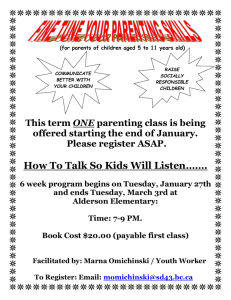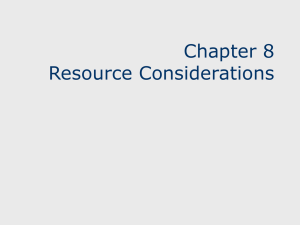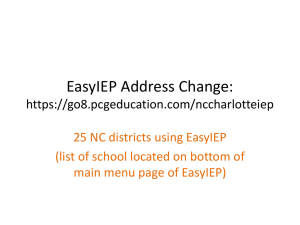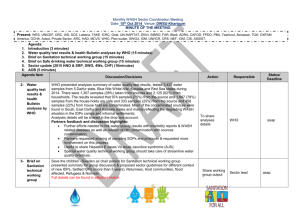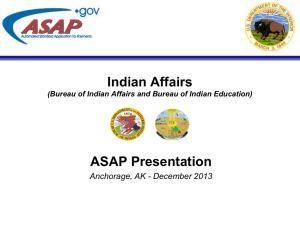attachment a homemaker standardsand personal care guidelines
advertisement
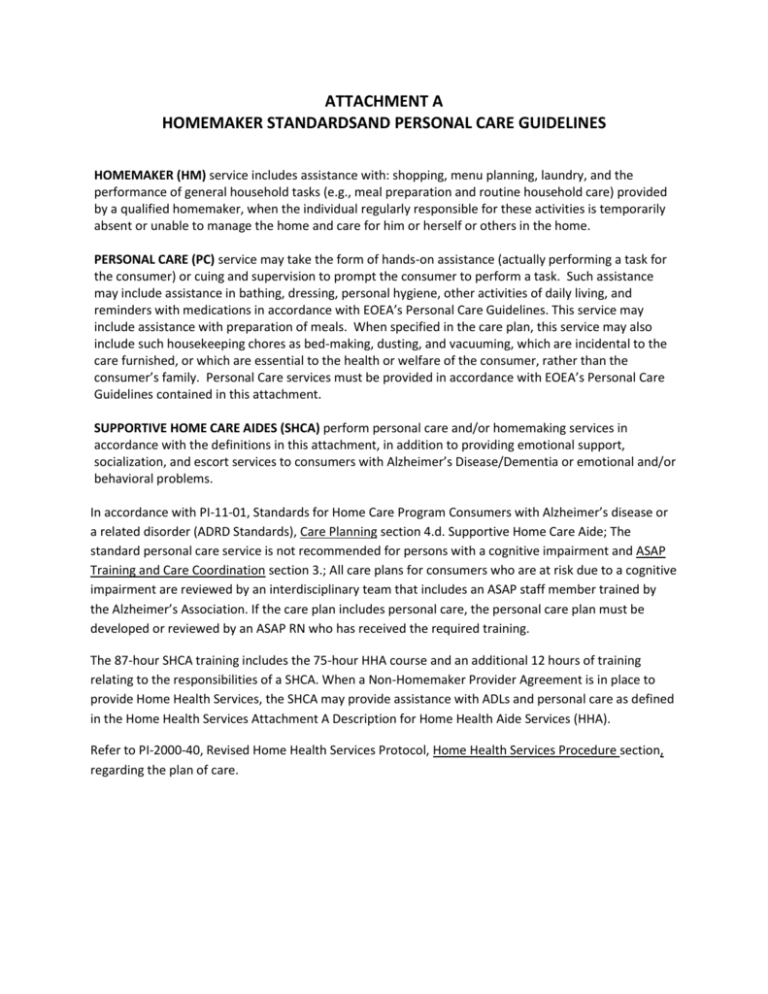
ATTACHMENT A HOMEMAKER STANDARDSAND PERSONAL CARE GUIDELINES HOMEMAKER (HM) service includes assistance with: shopping, menu planning, laundry, and the performance of general household tasks (e.g., meal preparation and routine household care) provided by a qualified homemaker, when the individual regularly responsible for these activities is temporarily absent or unable to manage the home and care for him or herself or others in the home. PERSONAL CARE (PC) service may take the form of hands-on assistance (actually performing a task for the consumer) or cuing and supervision to prompt the consumer to perform a task. Such assistance may include assistance in bathing, dressing, personal hygiene, other activities of daily living, and reminders with medications in accordance with EOEA’s Personal Care Guidelines. This service may include assistance with preparation of meals. When specified in the care plan, this service may also include such housekeeping chores as bed-making, dusting, and vacuuming, which are incidental to the care furnished, or which are essential to the health or welfare of the consumer, rather than the consumer’s family. Personal Care services must be provided in accordance with EOEA’s Personal Care Guidelines contained in this attachment. SUPPORTIVE HOME CARE AIDES (SHCA) perform personal care and/or homemaking services in accordance with the definitions in this attachment, in addition to providing emotional support, socialization, and escort services to consumers with Alzheimer’s Disease/Dementia or emotional and/or behavioral problems. In accordance with PI-11-01, Standards for Home Care Program Consumers with Alzheimer’s disease or a related disorder (ADRD Standards), Care Planning section 4.d. Supportive Home Care Aide; The standard personal care service is not recommended for persons with a cognitive impairment and ASAP Training and Care Coordination section 3.; All care plans for consumers who are at risk due to a cognitive impairment are reviewed by an interdisciplinary team that includes an ASAP staff member trained by the Alzheimer’s Association. If the care plan includes personal care, the personal care plan must be developed or reviewed by an ASAP RN who has received the required training. The 87-hour SHCA training includes the 75-hour HHA course and an additional 12 hours of training relating to the responsibilities of a SHCA. When a Non-Homemaker Provider Agreement is in place to provide Home Health Services, the SHCA may provide assistance with ADLs and personal care as defined in the Home Health Services Attachment A Description for Home Health Aide Services (HHA). Refer to PI-2000-40, Revised Home Health Services Protocol, Home Health Services Procedure section, regarding the plan of care. 1. PROVIDER POLICIES AND PROCEDURES a. A sufficient number of HM/PC workers should be available to meet the needs of consumers accepted for service. The provider shall accept or reject an ASAP service request by the end of the next business day. b. Providers shall have job descriptions and salary scales. c. A Criminal Offender Record Information (CORI) check shall be performed in compliance with the laws of the Commonwealth and any applicable regulations and guidelines issued by EOEA. d. Personnel files shall be maintained with documentation on the results of the interview and references; completed CORI investigation; training/in-service certificates, waivers and exemptions; if appropriate, PC skills checklist; supervisory visits; and performance reports and annual evaluations. e. Providers shall have policies regarding consumer privacy and confidentiality and nondiscrimination in service delivery. These policies shall prohibit discrimination against persons with AIDS/HIV and ensure that information concerning AIDS/HIV status is not apparent or accessible and is not released to anyone without specific written consent. f. Providers shall have an infection control plan to prevent occupational exposure to bloodborne illnesses including AIDS/HIV and Hepatitis B. The Center for Disease Control/OSHA guidelines for standard precautions shall be followed. g. Providers shall have policies to ensure tuberculosis screening and testing is performed for all provider staff who come into direct contact with consumers, using the CDC Tuberculosis Guidelines. h. Providers shall have policies for handling allegations of loss, theft, and/or damage of consumer property. i. Providers shall have a policy that prohibits the handling of the consumer’s money that includes, but is not limited to: reconciling checkbooks, writing checks, using bank cards/Automated Teller Machines (ATMs), or providing banking services. Checks may be used to pay for groceries if the check is written to the store. The ASAP may establish these special arrangements, including use of the Electronic Benefit Transfer card for grocery shopping, with the store. j. A plan shall be in place for dealing with emergencies in the consumer’s home, including accessing emergency medical services and contacting provider supervisors. k. Providers shall have a policy for incidents when the consumer does not answer the door, including the use of reasonable efforts (e.g. telephone) to gain access to the home. The provider will contact the ASAP immediately to determine the next course of action. l. Providers shall have policies to ensure compliance with the Department of Public Health’s (DPH) requirements regarding prevention, reporting, and investigation of abuse by homemakers and home health aides under105 CMR 155.000 et seq. as outlined in EOEA-PI07-03. Specifically, providers shall comply with all DPH regulatory requirements regarding hiring staff and reporting abuse. 2. REPORTABLE INCIDENTS a. If there is reasonable cause to believe a consumer has been abused, neglected, or financially exploited, the provider must immediately, day or night, contact the 24-hour ELDER ABUSE HOTLINE at 1-800-922-2275. b. The Provider must report to the ASAP the same business day any hospitalization, addition or loss of a household member, consumer’s absence from the home, alleged theft, alleged breakage of consumer’s possessions, injury to employee or consumer, or consumer complaint. c. The consumer and ASAP must be notified of a canceled visit or any variation in service delivery from the written authorization. d. The provider must report to the ASAP by the next business day a new consumer address, name, or telephone number; new MD, new diagnosis, and employee complaints. 3. QUALIFICATIONS a. Providers shall ensure that PCHMs are able to: perform assigned duties and responsibilities; communicate observations verbally and in writing; accept and use supervision; respect privacy and confidentiality; adapt to a variety of situations; and respect and accept different values, nationalities, races, religions, cultures, and standards of living. b. Providers shall ensure that supervision is provided by Social Workers, Registered Nurses, and/or professionals with expertise related to the consumer profiles. 4. TRAINING AND IN-SERVICE EDUCATION a. Prior to placement, all HM/PCHMs shall receive a 3-hour orientation (Mass Council's Training Curriculum or equivalent) with a 1/2-hour session on communicable disease including AIDS/HIV and Hepatitis B, infection control, and the principles of standard precautions. b. 40-Hour Homemaker Training: In addition to the 3-hour orientation, all HMs must complete 37 hours of training within the first 6 months of employment. The training shall include the nature and transmission of HIV/AIDS, standard precautions and other infection control practices, and protection of consumer confidentiality regarding AIDS/HIV. The Mass Council’s Home Care Aide course is recommended. Other courses may be used that contain the same subject matter and number of hours per subject. c. 60-Hour Personal Care Training: PC Workers must have completed the 20-hour PC training and the 40-hour HM training before providing PC. The Mass Council's PC training outline is recommended, with 17 hours of class instruction, including a review and demonstration on universal precautions, and a 3-hour practicum. The 3-hour practicum shall include an assessment of competency in each PC task before placement by using the Mass Council's skills checklist. d. Training must be conducted by an RN with a valid license in Massachusetts. A Registered Physical Therapist is recommended for the training on mobility. Return demonstrations are required on the hygiene and mobility sections of the training. The use of gaits belts is strictly prohibited. e. 87-Hour Supportive Home Care Aide (SHCA) Training: SHCAs must complete the following 87 hours of training before providing Supportive Home Care Aide Services: i) A 3-hour orientation (Mass Council for Home Care Aide Services Training Curriculum or equivalent) with a 1/2-hour session on communicable disease, including AIDS/HIV and Hepatitis B, infection control, and the principles of universal precautions. ii) The 57-hour Personal Care training set forth in the Personal Care Homemaker Standards issued by EOEA. iii) An additional 15 hours of Home Health Aide (HHA) training. The 75-hour HHA course prepared by the Mass Council is recommended. Other courses may be used if they contain the same subject matter and same number of hours for each subject. iv) An additional 12 hours of training related to the responsibilities of a SHCA. There are two SHCA training tracks: Mental Health Supportive Home Care Aide and Alzheimer’s Supportive Home Care Aide. a. Mental Health Supportive Home Care Aide - The following topics are recommended for Mental Health Supportive Home Care Aide: limit setting, depression, personality and character disorders, substance abuse, abuse and neglect, and the stigma of mental illness and behavioral disorders. The Mass Council’s curriculum is recommended. b. Alzheimer’s Supportive Home Care Aide - The following topics are recommended for Alzheimer’s Supportive Home Care Aide: understanding Alzheimer’s and Dementia, habilitation therapy, communication skills, personal care, behavior as communication, and working with families. The Alzheimer’s Association curriculum is required. f. Certificates: Providers must award a certificate to those who have successfully completed the HM, PC, or SHCA training. g. Training Exemptions: The following individuals are exempt from training requirements: i) Registered Nurses (RNs) and Licensed Practical Nurses (LPNs) with documentation of successful completion of a nursing program approved by the Massachusetts Board of Registration in Nursing or, when applicable, the appropriate nurse training approval authority in the state where the training was conducted; ii) Physical Therapists (PTs) and Occupational Therapists (OTs) with documentation of successful completion of a training program approved by the Massachusetts Board of Registration or, when applicable, the appropriate training approval authority in the state where the training was conducted; iii) Students enrolled in a nursing program approved by the Massachusetts Board of Registration in Nursing, with documentation of satisfactory completion of “Fundamentals of Nursing” course and/or one Medical /Surgical clinical nursing rotation; iv) Certified Nurse’s Aides with documentation of successful completion of a certified nurses aide training program; v) Home Health Aides with documentation of successful completion of a home health aide training program; vi) PCHM’s with documentation of having successfully completed the 60-Hour PC Training Program; vii) HM’s with documentation of having successfully completed the 40-Hour Training Program; and viii) HMs with documentation of having successfully completed the Homemaker Training Waiver Procedure, described in the Mass Council’s HTWP Guide, are exempt from the 37hour HM training program. ix) No exemptions for the additional 12-hour SCHA training. h. NOTE: All new employees exempt from any of the training components must receive the 3hour orientation described in the Mass Council Training Outline. In addition to providing a basic three-hour orientation, agencies should determine based on each individuals training how much, if any, supplemental training to homecare is recommended. i. Training Facilities: Agencies providing PC training shall have appropriate training facilities and equipment. A minimum standard of equipment shall include a bed with side rails, linen and blanket, running water and basins, towels and washcloths, chair, commode, wheelchair, and walker. A variety of teaching methodologies such as lectures, equipment demonstrations, visual aids, videos, and handouts shall be used. j. Supervisors and other professionals shall provide on-going in-service education and on-thejob training aimed at reinforcing the initial training and enhancing skills. This may be carried out with videos, lectures, group discussions, and demonstrations. k. A minimum of 6-hours per year of on-going education and training is required for all HMs and PC HMs. These hours shall be pro-rated for part-time employees. One to one PC supervision may comprise one-half the required hours. Instruction and reinforcement of universal precautions and infection control procedures count toward the required hours. l. Providers shall ensure that SHCAs receive a minimum of 12-hours per year on-going in-service education and on-the-job training provided by supervisors and other professionals. This may be carried out in a variety of ways such as video presentations, lectures, group meetings and demonstrations. 5. SUPERVISION a. Supervision shall be available during regular business hours and on weekends, holidays and evenings for HMs, PC Workers, and SHCAs providing services to consumers during these times. b. Supervision shall be carried out at least once every three months by a qualified supervisor. In-home supervision shall be done in a representative sample of consumers. c. PC Introductory Visits, including SHCAs providing personal care: On the first day of service in the consumer's home, a PC Worker shall receive an orientation from an RN to demonstrate the PC tasks. During this visit the PC Worker will demonstrate competence in the PC tasks assigned in the care plan. LPNs may carry out the orientation visits if the LPN has a valid license in Massachusetts, is working under the direction of an RN, and an RN from the ASAP has conducted an initial home visit to assess the need for PC prior to implementing the care plan. d. PC Supervision: An RN shall provide in-home supervision of PC Workers at least once every 3 months with a representative sample of consumers. A written performance of PC skills shall be completed after each home visit. LPNs may provide in-home supervision if the LPN has a valid license in Massachusetts, and works under the direction of an RN who is engaged in field supervision a minimum of 20-hours per week and is responsible for the field supervision carried out by LPN. e. SHCA Weekly Support: Each SHCA shall receive weekly support through training/inservices, team meetings, or supervision that includes in-home, by telephone, or in person. Team meetings shall be held quarterly and shall include SHCAs, supervisors, and other appropriate personnel involved in providing SHCA services. The focus of these meetings is to provide training and group supervision, to conduct case reviews or interdisciplinary case conferences, and to provide support to the SHCA. 6. CONSUMER RECORDS Providers shall maintain a record in a secure setting for each consumer receiving service. Access to consumer records shall be limited to provider staff involved with direct care of the consumer and appropriate administrative staff in compliance with EOEA’s Instruction on Privacy and Confidentiality. The record shall contain consumer information provided by the ASAP and the following information: Consumer Information available for viewing in Provider Direct: source/date of referral, documented Risk level, names of ASAP care managers, physicians, family/friends, date of service initiation and tasks to be performed, hours and duration of service/subsequent changes, record of services provided, and date of and report on termination. Consumer information not available for viewing in Provider Direct: medical and/or functional status, release of information forms, if applicable, notes regarding supervisory visits, team meetings, etc., and, reportable incidents (Section B). PERSONAL CARE GUIDELINES The goal of Personal Care (PC) Services is to provide care in a community setting, with the aim of maintaining the dignity and independence of consumers in a community setting for as long as possible. Personal Care (PC) services provide physical assistance and verbal cuing with personal care tasks such as bathing, dressing, grooming, ambulation, and transfers. PC services are provided to consumer who, based on an assessment performed by an Aging Service Access Point Registered Nurse (ASAP RN), need assistance with these types of services. The ASAP RN assesses the consumer’s overall functional and clinical status, the type and amount of care needed, the consumer’s environment, and current support systems, both formal and informal, in determining the appropriateness for PC. Consumers with conditions/diagnoses that may not be appropriate for PC services include, but are not limited to: consumers with extensive paralysis or total immobility, consumers requiring assist of two or use of a mechanical lift, severe contractures, open wounds, certain types of fractures including, but not limited to those casted to immobilize, unstable medical conditions, and those that require special skin care. The ASAP RN collaborates with the provider RN to ensure an individualized, comprehensive, and effective care plan for each consumer. The provider RN is responsible for orientation and ongoing supervision of the PC Homemaker (PCHM) to the care plan developed in collaboration with the ASAP RN.Licensed Practical Nurses (LPN), working under the supervision of an RN, may perform PCHM orientation and supervision in accordance with Attachment A Homemaker Standards. 1. BATHING a. Sponge bathing is allowed to maintain personal hygiene. b. Hot water must be well controlled and utilized with extreme caution. c. Bath oil products may not be used. d. Tub baths and showers are allowed on a case-by-case basis only after the ASAP RN has completed a nursing assessment. Consumers with conditions/diagnoses that may not be suitable for tub and shower baths include but are not limited to: consumers with a history of falls, severe osteoarthritis, severe osteoporosis, compression fractures, advanced neuromuscular disease, unmanageable seizure disorders, cancer with metastasis to the bone, peripheral vascular disease, severe cardiac/respiratory disease, vertigo, obesity, open wounds, and certain types of fractures including, but not limited to those immobilized with a cast. This may include a fairly recent hip fracture. e. Prior to approving a tub bath or shower, the ASAP RN must determine that no physical barriers exist that prohibit immediate access to the consumer in the event of an emergency. f. The following safety equipment is required for tub baths and showers: grab bar(s); a rubber mat, nonskid surface, or decals inside of the tub/shower; and a rubber backed floor mat outside of tub/shower. A tub/shower stool must be present when determined to be necessary by the ASAP RN. g. In certain cases, when it is not feasible to install safety equipment such as grab bars, the ASAP RN may waive the requirement of safety equipment when determining that the lack of safety equipment does not put the consumer’s safety at risk.The requirements regarding nonskid surfaces and the use of a rubber backed floor mat outside of the tub may not be waived. h. Complete bed baths are allowed on a case-by-case basis after the ASAP RN has completed a nursing assessment. The PCHM cannot take responsibility to turn, lift, or roll the consumer, but may assist the primary caregiver who is taking responsibility for these tasks. 2. SKIN CARE a. The application of over the counter emollients, excluding bath oil products, is allowed on a case-by-case basis as determined by the ASAP RN. The consumer must be alert, able to assume responsibility for the product, and able to direct the PCHM, but unable to complete the task independently because of physical limitations. b. Application of medicated creams and lotions is not allowed. This includes, but is not limited to over the counter products such as cortisone creams, Aspercream, Ben-Gay, anti-fungal products, Bacitracin and Neosporin or their generic counterparts. c. Care of ulcers/open wounds is not allowed. d. Treatments involving the application of heat are not allowed. This includes, but is not limited to hot packs, hot water bottles, and electric heating pads. e. Treatments involving the application of cold are not allowed. This includes, but is not limited to cold packs and ice. 3. FOOT CARE a. Foot soaks, limited to 10 minutes, and toenail filing are allowed. b. Foot soaks and toenail filing are not allowed on consumers with diabetes, severe peripheral vascular disease, or if the ASAP RN feels the consumer has a condition that would make this task inappropriate, such as an infection or an injury. c. Toenail cutting is not allowed in any instance. 4.GROOMING a. Shampoos may be provided unless restricted by the ASAP RN.The PCHM may comb, set with curlers/pins, and blow-dry the consumer’s hair. The blow dryer must be used on the low setting and in accordance with the safety recommendations of the manufacturer. The use of curling irons and/or electric curlers is not allowed. Hair cutting is not allowed. b. The use of any chemical hair product is not allowed. This includes, but is not limited to hair color, permanent wave products, henna etc. c. Fingernail cutting is not allowed. d. Fingernail filing is allowed unless the ASAP RN feels that the consumer has a condition that renders this task inappropriate such as an infection or an injury. e. Facial shaving with an electric razor may be provided. Safety or straight razors are not allowed. 5.DRESSING a. Assistance with dressing may be provided. Assistance with the application and removal of prescription and non-prescription anti-embolism stockings is allowed on a case-by-case basis as determined by the ASAP RN. 6. PERSONAL APPLIANCES a. Assistance with personal items such as denture care, assistance with hearing aids and eyeglasses, and help with the application of certain braces, splints, slings, and prostheses is determined on a case by case basis, based on the assessment of the ASAP RN. b. With the approval of the ASAP RN, consumers who have been using artificial limbs, splints, or braces on a continuing basis, may receive assistance with the application only if the consumer is: mentally alert, has received instruction and understands the correct application of the appliance, and the tension strap has been marked by the primary nurse or therapist to indicate the correct degree of tension. In the case of an arm or leg prosthesis, the residual limb must be well healed and shaped. c. Care of or insertion of contact lenses and application of new braces, splints, prostheses or slings is not allowed. 7.INCONTINENCE MANAGEMENT a. Incontinence management may be provided. This includes assistance with the use of the toilet, commode, bedpan, or urinal. When assisting with the use of the bedpan, the consumer must be able to lift his/her buttocks onto the bedpan independently or with the aid of a trapeze. Assistance on and off the commode must comply with transfer guidelines listed below. Incontinence assistance includes assisting with bowel/bladder training regimes, disposable incontinent briefs/pads, and personal hygiene. With the approval of the ASAP RN, the PCHM may remind the consumer to perform pelvic strengthening exercises, e.g. Kegal exercises. b. The emptying of urinary drainage bags, the application of urinary leg bags, and routine catheter care are allowed with ASAP RN approval. The PCHM must be able to demonstrate competency by means of return demonstration of these techniques to the Provider RN. c. The application of a condom/Texas catheter is not allowed. d. Ostomy care, in most cases, is not allowed. With approval of the ASAP RN, occasional exceptions may be made when the ostomy is long-term, well-healed, and without complications. In those cases when a consumer has received and understands instruction in stoma bag application, but is not able to manage it due to physical limitations such as poor vision or severe arthritis, assistance may be given by the PCHM in applying the bag. The PCHM must be able to demonstrate competency by means of a return demonstration of this technique to the Provider RN. e. Manual disimpactions and the administration of douches and enemas are not allowed. 8. TRANSFERS a. Assistance with transfers is allowed when the consumer is able to bear at least 50% of his/her weight when moving from a sitting to a standing position and while transferring. The ASAP RN may approve transfer assistance when the consumer’s caregiver provides support for 50% of the consumer’s weight. The ASAP RN may also approve assistance with slide board transfers. The PCHM must demonstrate competency by means of a return demonstration to the Provider RN. b. Use of mechanical lifts and participation in a two-person carry of a totally dependent consumer is not allowed. 9. AMBULATION a. The PCHM may assist the consumer with ambulation inside and outdoors, as well as with a walker, wheelchair, and/or cane that has been properly fitted to the consumer. The personal care plan shall specify where ambulation assistance may take place, e.g. “consumer may be assisted with ambulation outside”. The ASAP RN, on a case-by-case basis, may approve assistance with stair use. b. Consumers who are following a written exercise program may be coached by the PCHM in carrying out active range of motion and strengthening exercises. The care plan must be very specific with regard to the exercises to be performed and supported with orders/instructions from either a physician or a physical therapist. c. Active participation in an exercise program, or passive range of motion exercises are not allowed. 10.NUTRITION a. The PCHM may prepare and set up meals, and provide encouragement and/or cuing for food/fluid intake as appropriate. The ASAP RN may approve feeding consumers on a case-bycase basis. b. Tube feedings, syringe feeding, and the feeding of consumers with a history of choking and/or swallowing difficulties are not allowed. 11.MEDICATION ASSISTANCE a. Administration of medication, prescription or non-prescription, and/or oxygen is not allowed. b. The PCHM may not participate in any aspect of automated medication dispensing systems. c. The PCHM may remind the consumer to take his/her medications. d. The PCHM may place the medications within reach of the consumer. e. On a case-by-case basis, the ASAP RN may approve that the consumer direct the PCHM to act as the hands and/or eyes of the consumer. f. If, by reason of poor vision or other physical limitation, the consumer needs help with the mechanical aspects of medication administration, e.g. reading medication labels or opening medication packaging, the PCHM may provide mechanical assistance. g. The ASAP RN must determine and document in the consumer record that the consumer has met the following criteria: The consumer is aware that they are taking medications. The consumer is alert and assumes responsibility for taking his/her medications, but requires assistance because of physical limitations. The consumer is able to direct the PCHM in assisting him/her with the mechanical aspects of medication administration. The medication is an oral medication. The PC plan includes a directive to provide the assistance. 12. RESTRAINTS The PCHM is not allowed to provide care to the consumer when a physical restraint is in use. This excludes the use of side rails if the use of side rails has been approved by the ASAP RN as a necessary safety measure and the consumer is in agreement with and understands their use.

